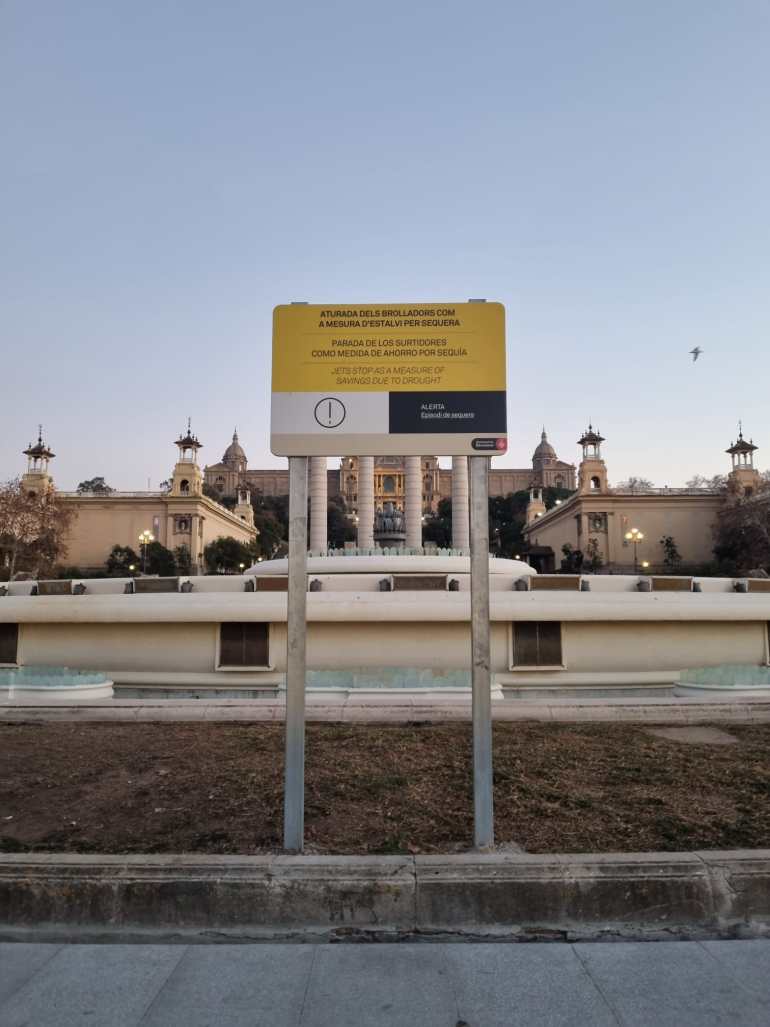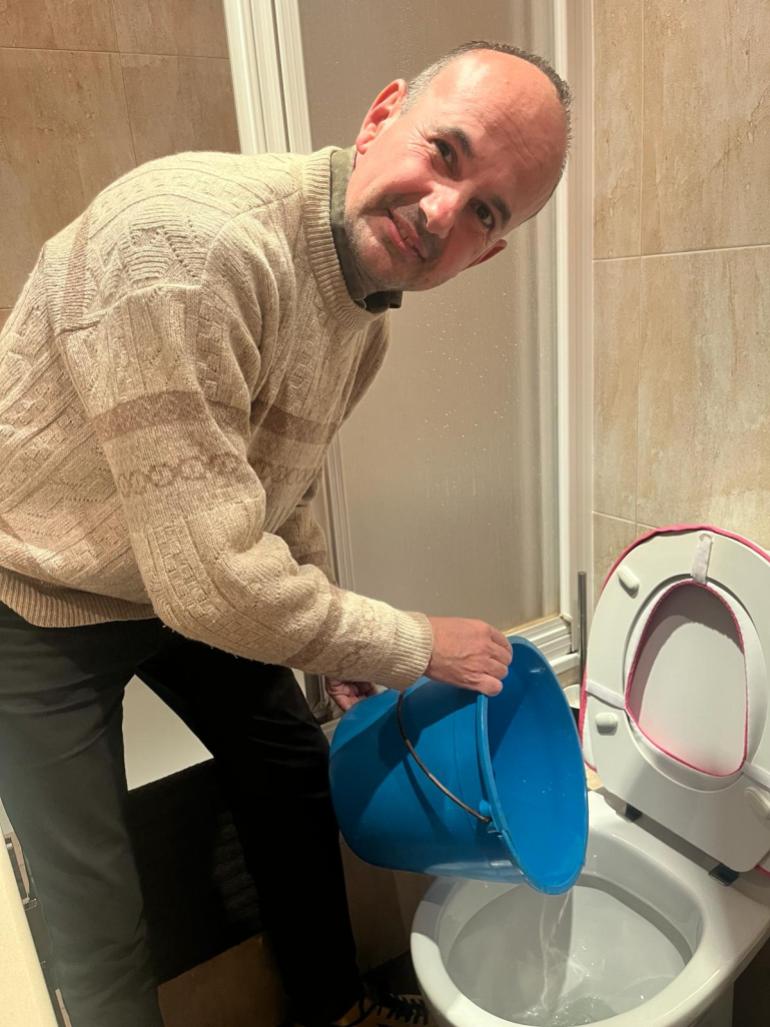Barcelona, Spain – The Magic Fountain is a popular tourist attraction where colorful jets of water shot into the air while classical or pop favorites played.
No longer.
Like fountains across Barcelona, it sits dry and somewhat deserted with signs saying “Fountains shut down due to drought.”
The free water feature music show, which ran for almost 100 years, is another victim of what Catalan authorities have described as the “worst drought ever” in northern Spain.
After three years without sustained rainfall, emergency measures were taken over the weekend, including a ban on refilling or topping up swimming pools at hotels or campsites unless recycled water is used.

If the skies do not open in the next few months, Spain could order two ships a day to transport water from Valencia to the Catalan capital, Barcelona port authorities said.
Tourists visiting Catalonia – Spain’s most popular tourist region, which attracted 18 million visitors last year – face the closure of swimming pools as experts predicted pools will inevitably dry out due to spills and evaporation.
The only exception is swimming pools used for medical reasons.
Fears of summer
With the lucrative summer tourist season, campsites are looking for ways to use seawater in pools. One option could be to add seawater to fill pools, but that is expensive.
Washing cars and watering public gardens were banned under the first stage of this emergency plan – unless the water comes from an approved recycling system.
Swimming clubs with outdoor pools are initially exempt from this, but they are prohibited from using showers. Television reports showed that showers were taped off so they could not be used. Beach showers were turned off.
On the beach in Gava, a town south of Barcelona, Lavinia Mestre took advantage of the unusually hot weather for February to take a quick swim.
“I know some people who no longer come to the beach because of the lack of showers. But I bring a bottle and use the sea water to remove the sand from my legs,” Mestre, a 20-year-old student, told Al Jazeera.
“I understand why they turned off the showers, and it’s not a big sacrifice in the middle of a drought.”
“Worst drought ever”
In Barcelona, many were inspired to take action after months without rain.
While Ana Miquel waited for the water in her kitchen to heat up, she collected five liters in a bottle.
“We have no choice but to save water. It’s silly to waste water when we have a chronic drought,” Miquel, 65, a retired hotel manager who lives in Barcelona, told Al Jazeera.
The restrictions affect around six million people in Barcelona and 200 cities, or around 80 percent of the region’s population.

Miquel Marti, university lecturer in urban planning in Barcelona, believes that people need to change their behavior while living in a drought.
“We put a bucket in the shower to catch water and then use it in the toilet. We use less water to wash dishes and make sure that the washing machine doesn’t run for too long. We have to change our way of life,” Marti, 50, told Al Jazeera.
Authorities are under no illusions about the severity of the drought, which the Spanish government says has caused reservoirs in the region to fall to 15.8 percent of normal.
“It is the worst drought ever recorded,” Pere Aragones, Catalonia’s regional president, said at a news conference last week.
The emergency measures are intended to reduce the daily allowable amount for residential use from 210 to 200 liters (55 to 53 gallons) per person.
According to the World Health Organization, an average 10-minute shower uses 150-200 liters (40-53 gallons).
Most households in Barcelona are already well below this limit. However, according to a 2016 survey by development agency Barcelona Regional, hotels use far more water. This found that hot tubs and pools in five-star establishments use more than 540 liters (143 gallons) per guest per day.
The Barcelona Hotel Guild, an industry association, hit back by releasing a 2022 report claiming that after years of campaigning for sustainable water use, average daily water consumption per person in five-star hotels had risen to 242 liters ( 64 gallons) sank.
Yurbban Hotels, which has three hotels in Barcelona, asked guests to take on the “Four Minute Shower Challenge”.
“We decided to go one step further and involve our guests so they can shower in four minutes,” said Javier Diaz, director of hotels and sustainability.
If there is no rain before spring, the personal daily limit is lowered to 180 liters (47 gallons) and then to 160 liters (42 gallons).
Under the new restrictions, irrigation in agriculture must be reduced by 80 percent – water use in livestock farming by half and in industry and leisure by 25 percent.
If triggered, a second phase of restrictions would see showers in gyms switched off.
“Climate without rain for years”
Catalonia’s water crisis comes after Spain and other parts of Europe suffered a series of heatwaves last year that depleted reserves through evaporation while consumption rose.
Authorities in Andalusia in southern Spain are also considering similar emergency measures due to a severe drought.
Antonio Aretxabala, an expert in hydrology at the University of Zaragoza, said Spain’s water crisis was due to a lack of rain and the overuse of water for agriculture, which accounts for only 2.3 percent of the country’s gross domestic product.

“We have had a climate without rain for years and exorbitant water consumption for agriculture. Agriculture accounts for around 85 percent of water consumption. The rest is for human and industrial use,” he said in an interview with Al Jazeera.
“Spain is one of the driest parts of Europe, but has one of the largest hydraulic footprints in terms of the type of products we export, such as tomatoes or other fruits.”
Aretxabala said people had adapted their behavior to climate change, but agriculture had not changed fast enough.
The drought is not only affecting people, but is also damaging trees that are essential for absorbing carbon dioxide to prevent further climate change.
“The lack of rain means the trees are weaker and more susceptible to disease and desiccation. This means they can absorb less carbon dioxide and the risk of forest fires is greater,” said Marta Gonzalez Santis of the Catalan Technological Forest Center, which published a study report on Monday about the damage that climate change is causing to the vegetation cover.






Recent Comments